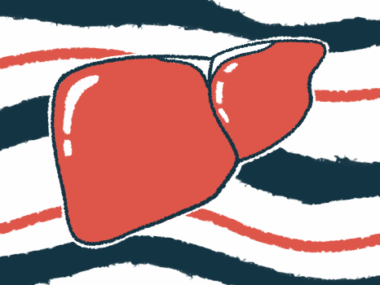Blood levels of GDF15 protein may help in liver cancer risk of MASLD
High levels seen in study to be risk factor independent of fibrosis stage
Written by |

High blood levels of the growth differentiation factor 15 (GDF15) protein are associated with an elevated risk of liver cancer and other liver-related complications among people with metabolic dysfunction-associated steatotic liver disease (MASLD), a study showed.
Data also supported a greater likelihood of such complications developing in MASLD patients with both high GDF15 levels and intermediate- to high-risk liver stiffness, a known risk factor of liver cancer.
Findings suggest that these two markers help to identify MASLD patients in need of regular liver cancer monitoring.
“By identifying patients who are prone to develop liver cancer from steatotic liver [MASLD] and conducting periodic examinations, [the] detection and treatment of liver cancer may be possible in its early stages,” Hayato Hikita, MD, PhD, the study’s first author and an associate professor at Osaka University in Japan, said in a university press release.
“Early detection and treatment of liver cancer are also expected to lead to improved prognosis,” Hikita added.
Liver cancer in MASLD patients often is not detected until advanced
The study, “Serum growth differentiation factor 15 is a novel biomarker with high predictive capability for liver cancer occurrence in patients with MASLD regardless of liver fibrosis,” was published in Alimentary Pharmacology & Therapeutics.
MASLD, previously called nonalcoholic fatty liver disease, is characterized by the accumulation of fatty deposits in the liver. At its onset, MASLD usually doesn’t cause serious health issues.
But left unaddressed, liver inflammation and scarring, or fibrosis, can set in, a condition known as metabolic dysfunction-associated steatohepatitis, or MASH. Ultimately, these patients may experience serious consequences like irreversible liver damage and fibrosis (cirrhosis) or liver failure.
Uncontrolled, MASLD also can lead to liver cancer. While it is critical to detect and treat this cancer as soon as possible, liver cancer in MASLD patients often is not found until it has advanced substantially, Hikita noted.
Fibrosis is a strong risk factor for liver cancer development, and current screening strategies rely on assessing a patient’s stage of liver fibrosis when determining how closely they should be monitored.
Such monitoring typically begins with a noninvasive test called fibrosis-4 index (FIB-4), in which a score higher than 1.3 indicates an intermediate to high risk of advanced liver fibrosis.
Among at-risk patients identified using this index, “those with advanced fibrosis are recommended to undergo liver cancer surveillance, but those without advanced fibrosis are not,” the researchers wrote. “However, some patients without advanced fibrosis will develop liver cancer. Thus, the development of a novel biomarker to predict liver cancer development in patients with [MASLD], independent of fibrosis stage, is in high demand.”
High GDF15 levels are found in various types of cancer
GDF15, an inflammatory signaling molecule, is found at increased levels in various types of cancer, including liver cancer associated with hepatitis. The protein’s levels also have been shown to predict advanced fibrosis in MASLD patients.
Hikita and colleagues evaluated whether blood GDF15 levels could be a predictive marker of liver cancer and other liver-related events in people with MASLD.
They measured the protein in 518 people with biopsy-confirmed MASLD, and then monitored them for liver-related outcomes over a median of 63 months, or more than five years.
During follow-up, 22 patients (4.2%) developed liver cancer, and elevated GDF15 levels were found to be an independent risk factor for this complication. Having a Fib-4 index score higher than 1.3 also was predictive of liver cancer.
Based on a protein cut-off value of 1.75 nanograms per milliliter (ng/mL), patients with higher GDF15 levels were significantly more likely to develop liver cancer than those with lower levels at three (4.8% vs. 0%), five (7.7% vs. 0%), and seven years (14.9% vs. 0.7%).
These rates rose further among patients with high GDF15 blood levels and a Fib-4 index greater than 1.3 (5.3% at three years, 8.6% at five years, and 16.9% at seven years).
Blood GDF15 levels above 1.75 ng/mL linked with higher liver cancer rates
During follow-up, 24 patients (4.6%) experienced a liver decompensation event, when liver function suddenly declines in a person with cirrhosis. Moreover, 16 patients (3.1%) had cardiovascular events and 12 people (2.3%) died, seven of them due to liver-related complications.
Blood GDF15 levels above the cut-off value significantly associated with a higher incidence of decompensated liver events, liver-related death, and overall death.
Researchers then validated their findings in a group of 216 other MASLD patients, again finding that high GDF15 levels significantly linked to higher rates of liver cancer and a worse overall prognosis.
Data also suggested that combining both high GDF15 levels and a high Fib-4 index score “could be an efficient marker for identifying patients at high risk for liver [cancer] or other related events,” the researchers wrote.
They suggested that routine liver cancer screenings be given patients with a high Fib-4 index score and elevated GDF15 levels, regardless of how advanced their liver fibrosis is determined to be in a biopsy, allowing the “early detection of liver cancer in larger numbers of MASLD patients.”
Applying this approach at routine health check-ups “would be able to pick up high-risk patients efficiently … and could be a useful biomarker … not only at liver specialty clinics or hospitals but also at primary care clinics or health checks,” the researchers concluded.







